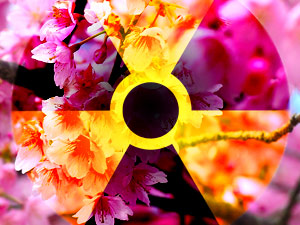 |
| Cherries or Chernobyl equation/ photo illustration: Vijay Verghese. |
PLANET EARTH is a patently unsteady place. With molten lava at its core, violent eruptions through volcanic vents, and irascible floating tectonic plates jostling for elbowroom at the surface, it is hardly the picture-postcard for aliens in search of splendid sanctuary. Yet close to seven billion people inhabit this lonely and beautiful but terrifyingly unpredictable orb.
The 11 March, 2011, Japan earthquake measuring 9.0 on the Richter scale, starkly underscored human frailty as a tsunami and then radioactive leaks from the Fukushima nuclear reactors, followed swiftly in its wake. Unlike the 2004 Boxing Day temblor, also a 9.0, that hit the Indian Ocean rim with a surging tsunami after the initial jolt in Aceh, Indonesia, the Japan event has long-term ramifications. Rebuilding is part of it. Radiation is another.
After the Asian tsunami we called for travellers to return to the battered shores to help rebuild local economies with valuable tourist dollars. Returning visitors in large part helped fuel and shape the rebuilding process. But, unlike Thailand, say, Japan is far less dependent on tourism. It is the world’s third largest economy, after USA and China (which just overtook it). While hobbled by intermittent recession it produces a huge proportion of the world’s semi-conductors and electronic components, a vital supply line now at risk.
Send us your Feedback / Letter to the Editor
Despite inordinate reserves of goodwill, Japan will not attract huge numbers of returning visitors. At least, not until radiation fears have abated. Cesium-137, a radioactive by-product of nuclear fission that has been vented along with steam from the stricken reactors, has a half-life of 30 years. Plutonium-239 has a half-life of 24,000 years. That’s a long while. And small amounts of Iodine-131 have been found in Tokyo’s water supply. The challenge for the government is robustly underlining safety without being ham-fistedly alarmist. Travellers face a similar dilemma.
Sakura in April when the cherry blossoms are in spectacular bloom is an event that epitomises all that is wonderful about Japan. This year, it is a quiet, sombre season. (Outbound travel from Japan is also seriously curtailed and Hawaii alone estimates a US$200 million loss in tourism revenues for the first half of 2011.)
The 22 February Christchurch quake was a 6.3 magnitude tremor. Tragic as it was, this was a relatively modest event compared with the 10 biggest earthquakes since 1900 that crossed a bone jarring 8.0 or 9.0 on the Richter scale, from Ecuador, Chile, Indonesia, and Tibet, to Alaska and the Kamchatka peninsula in eastern Russia.
So, should we fear travel? Certainly not.
Take a look at the “Ring of Fire”. This fearsome moniker is applied to the intensely active seismic and volcanic ring girdling the Pacific, encompassing places as innocently diverse as New Zealand, Philippines, Hawaii, Latin America, California, Chile, and Japan. This is where the ill-tempered Pacific Plate bangs heads with the unyielding Indo-Australian, Antarctic, North American and Nazca Plates. Yet, based on this scientific fact, is anyone going to cancel their holiday?
Cesium scatter and groundwater contamination is no small matter of course, but it shall ultimately need to be placed in perspective after calmer minds have made a sober asessment
Alaska has been rocked by tsunami-generating earthquakes three times in the past half century, in 1957, 1964 and 1965. But cancelling a visit to Alaska would be to miss out on incredible, windswept snowscapes, minus-forty weather, raging blizzards and 25,000 Inuits wondering what on earth they’re doing there welcoming tourists when they should be sunning themselves in the Maldives.
Following the 1986 Chernobyl meltdown an exclusion zone of 30km was immediately set up. It remains until today. Ironically, wildlife and forests have thrived in this area largely due to the elimination of human interference, though with what long term effects, remains to be seen. Chernobyl was rated seven on the nuclear disaster scale. Fukushima was classed as a five and later upgraded to seven though with a one-tenth severity on the radiation scale. Strung out across the northwest Pacific, the Japanese islands run over 2,000km in length. Even with a substantially larger exclusion zone, this leaves the major part of the country open for business.
Cesium scatter and groundwater contamination is no small matter of course. But it shall ultimately need to be placed in sensible perspective when calmer minds have assessed the situation more thoroughly.
Panic has nimble feet. Shortly after Fukushima radiation levels rose, Chinese shoppers raced to supermarkets to buy up salt, fearing imminent contamination. Hong Kong followed suit, prompting the local SAR government to step in firmly to dispel nonsensical rumours. Yet salt prices in the territory shot up almost tenfold. Hong Kong later blocked food imports from the five Japanese prefectures of Fukushima, Gunma, Chiba, Ibaraki, and Tochigi.
The Great Kanto Earthquake of 1923 turned much of Tokyo into rubble. Kobe was hugely rattled in 1995. But Japan gamely surged back. This time, the cost of recovery is estimated at a staggering US$300 billion. Asian Tsunami donations after the December 2004 event amounted to over US$14 billion in humanitarian aid. So if not immediate travel, there is another way to give back to Japan.
Whichever way you cut it there is no escaping the fact that life is fragile. The world is a wonderful place. You may as well go out and enjoy it. Grab a Singha beer, practise your Bahasa Indonesia, cavort with Dolly the cloned sheep, rub noses with Inuits, enjoy a Chilean fiesta, and do think about visiting Japan when the time is right. You’ll return radiant, for all the right reasons.
Send us your Feedback / Letter to the Editor |